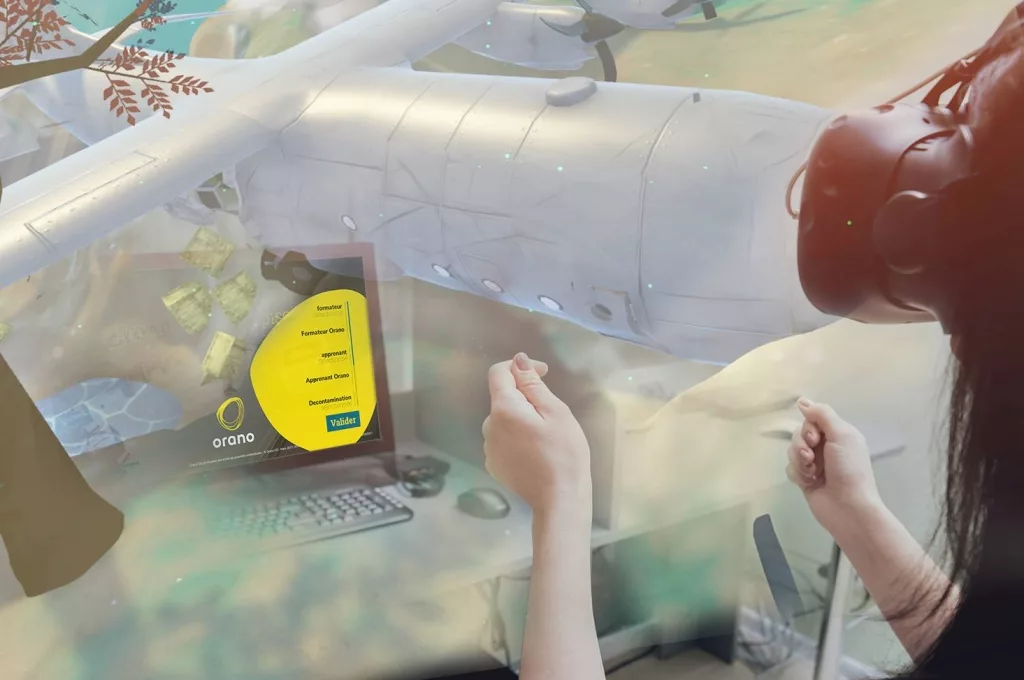Due to its realistic immersion, experiential nature, and
safety, customization, engagement, and its ability to provide
instant feedback, VR is a powerful tool for enhancing
learning, knowledge retention, and the development of
skills. However, during their initial experience in virtual reality
VR), learners may be fascinated by this “new world”
and may encounter challenges in getting accustomed to this revolutionary
technology. UDACE recommends five steps to ensure the
success of your projects.
Step 1: Discovering Virtual Reality
The initial step is to discover virtual reality. Some users have never had the opportunity to experience it, and they may feel overwhelmed by the intense sensations that this new technology provides. The reactions of novices vary from person to person. Some struggle to concentrate and focus their attention, while others feel overwhelmed by the potential of this new universe. That is why it is highly recommended to accompany users during their first VR experience, providing them with short and guided initial experiences that incorporate playful elements to facilitate immersion and understanding of the technology.
Step 2: Getting Familiar with VR Application Features
Mastering the features of the virtual reality (VR) application. Once you have overcome the initial sensations associated with immersion in a 360-degree virtual world, you must learn to interact within this universe. This involves simple actions such as moving, orienting oneself, touching or grabbing objects, as well as more complex operations like opening an inventory, using a fire extinguisher, or even operating a crane. It is important to explore the different ways of interacting with this virtual environment. A tutorial can guide you step by step in learning the different actions, thereby avoiding any frustration. The smoothness of the user experience plays a crucial role in the enjoyment of learning and its retention.
Step 3: Preparation for the scenario execution
Step 3 implies preparation for Scenario Execution.
of the educational scenario in VR. One of the challenges that learners face is
linking their actions and interactions in the virtual environment
to their gestures. Sometimes, pre-action reflection disappears in
favor of mechanical repetition. When learners return to the
reality, even the slightest difference from the VR experience can unsettle them.
To address this issue, AUDACE recommends introducing
each educational scenario in VR with a detailed explanation of the various
steps of the process, using screenshots to illustrate the
actions to be performed. This allows the learner to better understand the logic and
the chronological order of operations, which promotes the memorization of
learning, reduces the need for repetitions, and facilitates the transition between
virtual training and real work.
AUDACE also suggests designing each scenario
of learning with at least two gameplay modes: a beginner mode where all
the steps are indicated to the learner, allowing them to complete
the entire scenario without prerequisites, and an “expert” mode without
any indications, to ensure that the learner is capable of reproducing
the process without assistance.
Step 4: Designing an Educational Scenario.
To optimize the learning experience, it is recommended to design educational scenarios with a maximum duration of 20 minutes. Beyond this duration, learners can become fatigued and the memory anchoring is less effective. To facilitate a smooth and enjoyable learning experience, it is essential to minimize the cognitive load on the learner regarding the actions required to progress in the scenario. This involves developing intuitive interactions, a natural progression, as well as adding sound and visual effects that provide consistent feedback.
Step 5: Debriefing the Experience.
When virtual reality is used in a supervised training setting, the debriefing phase offers an opportunity for memory anchoring that should be optimized. AUDACE advises dividing this debriefing phase into two steps: firstly, allowing the learner to express their emotions and release them, similar to how a sports coach lets their players express themselves during a timeout to ensure their focus. Then, the trainer can focus on debriefing the pedagogical aspects of the learner’s experience (what they saw, accomplished, and experienced).
Virtual reality provides immersive and stimulating learning opportunities, but it requires a structured approach to ensure an optimal user experience. By following the mentioned steps, learners can fully benefit from this highly effective technology to acquire new skills and knowledge safely.

